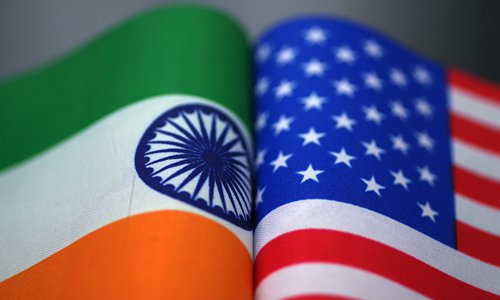HOME >> OPINION
US defense cooperation proposal with India defies win-win results
By Long Xingchun Source:Global Times Published: 2019/6/16 18:03:40

Photo: IC
The Bureau of the Political-Military Affairs (PM) of the US Department of State on June 4 issued a fact sheet titled "US Security Cooperation With India" stating that "India plays a vital role in the US vision for a free and open Indo-Pacific," and adding the US would advance its defense trade relationship and broader security partnership with the country.According to the fact sheet, the US has supported the increase in total defense trade with India, which was at zero over a decade ago and now stands at $15 billion for 2019. In 2016, the US designated India as a Major Defense Partner. In 2018, India was granted Strategic Trade Authorization tier 1 status, which allows it to receive license-free access to a wide range of military and dual-use technologies that are regulated by the Department of Commerce.
In the past over one decade, the US has been aggressive in promoting defense cooperation with India, including selling weapons, relaxing limits for technology transfer, and carrying out military-industrial collaboration.
The fact sheet articulated that defense cooperation with India provides "critical opportunities to enhance India's military capabilities and protect shared security interests in the Indo-Pacific region."
Washington is presenting its military cooperation with India in new wrapping paper of the Indo-Pacific strategy, yet the fundamental reasons for US arms sales and security collaboration with India have not changed.
Washington wants a greater share of India's growing arms market. Since the beginning of the 21st century, India has become one of the world's major weapons importers. Arms purchases by New Delhi increased rapidly.
Other than maintaining its tradition of purchasing weapons from Russia, India has since expanded its arms import channels and has turned to the US, France, and Israel. The move has intensified competition within the Indian arms market.
The US has always used the arms export business as a vital tool to gain economic interests and strategic influence. Expanding arms sales to India can not only create profit for Washington but also squeeze Russia out of India's market, a maneuver that would help New Delhi become more strategically pro-US.
Since Indian Prime Minister Narendra Modi assumed office in 2014, he has wasted no time at all in promoting the "Make in India" strategy, which could help attract US military-industrial companies to produce weapons in India.
However, after US President Donald Trump took office, his policy of bringing manufacturing back to the US runs contrary to Modi's domestic strategy. Although Washington eased technology transfer restrictions to India it eyes more for selling India weapons, while India wants to obtain US technology by sharing its market. Such contradiction increases the uncertainty of US-India joint weapons production on Indian soil.
For India, the US is not its only partner in defense cooperation. New Delhi remains Russia's top weapons client. Indian military technicians and officers have received training from Russia. Right now, India is unable to replace Russian weapons with those made in other countries.
Regarding strategic mutual trust, India-Russia ties have withstood historical tests without conflict of interests emerging between the two. In India's strategic circle, Moscow is more reliable than Washington.
Even if India is seeking weaponry and military technologies from other countries apart from Russia, it would never put all its eggs in the US basket. Only in that way could India have more options and raise its bargaining power when purchasing weapons.
In the economic sector, the US is not a reliable partner. Modi has made economic development his top priority. He hopes to boost globalization and maintain the authority of international multilateral mechanisms such as the United Nations and the World Trade Organization. However, Trump is doing the opposite.
When it comes to bilateral trade ties, the US imposed tariffs on steel and aluminum imports from India, ended sanctions waivers for India on the issue of Iranian oil import, and removed India from its preferential trade treatment list.
The US intends to encourage India to cooperate with its Indo-Pacific strategy to contain China. However, as a significant regional power and a potential major global power, New Delhi adheres to strategic autonomy. It hopes to shape the Indo-Pacific region from the perspective of its own interests. Therefore, India will not support the US Indo-Pacific strategy, which would only serve Washington's interests.
The author is a senior research fellow with The Charhar Institute and director of the Center for Indian Studies at China West Normal University. opinion@globaltimes.com.cn
Posted in: ASIAN REVIEW